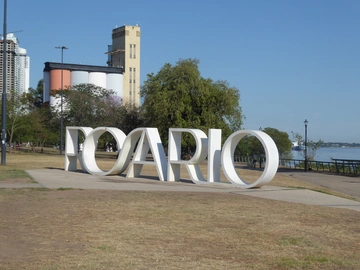Illegal arson, civil resistance and collective action in Rosario, Argentina
September 14, 2023.
Rosario, February 2023. We return from Cordoba, Argentina’s second-largest city, where we paid a visit to one of the nine global Right Livelihood Campuses. There, we met with Raul Montenegro, an RLC-laureate who received the Right Livelihood Award in 2004 for his work with local communities and indigenous people protecting the environment. The journey leads through the eternal pampas of Argentina and passes Rosario, a city 280 kilometers north of Argentina’s Capital Buenos Aires. A heat wave has gripped this part of South America, lasting several months from November 2022 to March 2023 and keeping the entire country in suspense.
Argentina’s exceptional heat wave
In Buenos Aires, the Argentine Weather Service recorded the highest temperatures since 1961. This record was replicated in Rosario, Argentina’s third largest city, counting 1.3 million inhabitants. It is located in the Province of Santa Fe, between the two huge rivers the Paraná and Paraguay, in the middle of a delta with 5,600,000 hectares of wetlands. These extremely fertile soils have made the region an attractive place for agriculture and livestock since the colonization by the Spanish. And it still is the country’s main area for industrial agricultural and livestock production. Unfortunately, Rosario is also the epicenter of wetland fires, which have gotten completely out of control since 2020, during the Covid-19 pandemic.
Rosario: Famous past, furious present
Rosario is known as the 'Cradle of the Flag', as it was here that the Argentine national flag was hoisted for the first time in 1812. A monument honoring this event, the Monumento a la Bandera, completed in 1957, is an emblematic and symbolic construction for the national state. But, it is also a site of numerous official, civic, and protest acts such as marches and demonstrations. The wetland fires have provoked unprecedented protests by manifold environmental movements.
Since colonial times, natural land has been transformed on a large scale. This so-called ‘pampeanization’ of the wetlands is a kind of historical given and rarely questioned. Thus, fires are set repeatedly to gain new land for human activities such as cattle herding, new cropland but also intensive agriculture, and construction, as the city of Rosario is expanding.
Fires threaten livelihoods and habitats
Many wetlands fires are caused by illegal arson, a phenomenon plaguing the whole country and continent, as fires have also been destroying large areas of the Gran Chaco and the Amazon region. The dynamics are similar everywhere: Agricultural companies intentionally burn supposedly ‘unused’ land to later buy it up at knock-down prices for cattle ranching or soybean production. Thus, the boom of soy production in the late 1990s and the growth of the cattle industry have contributed to a rising number of fires.
The fires in Rosario’s wetlands affect not only the population living in the surrounding areas but also the flora and fauna - to such an extent that stricter legislation would be needed to protect the wetlands. The fires pose a threat to the resilience of native species and the unique biodiversity landscape in the floodplains, which are already under stress from droughts and further impacts of climate change.
Making a difference: Environmental and civil movements in Rosario
The environmental movement in Rosario has been gaining momentum since 2020. It consists of a variety of actors ranging from citizens, university students, left-wing political groups, conservationist activists and feminists. They are organizing massive acts of protests, expressing a repertory of new ‘languages of valuation’. The environmental activists’ demands are clear: Stricter legislation for the protection of wetlands and more consistent punishment of illegal arson.
These demands are creatively staged, with people and things merging into collective protest assemblages. The feminist art collective Thigra regularly organizes acts of protest against ecocide. In a protest under the motto “Tu fuego es complice” staged in November 2020, more than 200 people participated in a human chain with buckets of water to extinguish the fire in the National Monument, which stands for freedom and Argentina’s independence.
Through these protests the collective wants to point to the responsibility of the state and municipal administration. Who seem to ignore the problem deliberately. People regularly undertake breakneck and life-risking actions such as attempts to extinguish the fires, especially when they reach the islanders’ houses, while representatives of the city administration and state stand by idly.
Twenty years after Raul Montenegro was awarded the Alternative Nobel Prize, ecosystems in Argentina and throughout South America are under threat. This makes everyday protests by people affected by this threat all the more important. Their creative protests exemplify that resistance practices can be collectively organized, while new sources for alternative ideas of knowledge production and concepts for living can be created.
This article is based on a previously published ZEF blog post.
Authors:
Eva Youkhana is Acting Director at ZEF. She spent a sabbatical term in Argentina in 2023.
Contact: eva.youkhana@uni-bonn.de
Francisco Preiti is an Assistant Professor at the National University of Rosario
Contact: franciskojose03@gmail.com
This article was published in ZEF News No. 47.



